IMAT5205 - Systems Analysis: Object-Oriented Iterative Life-Cycle
VerifiedAdded on 2023/05/29
|11
|2043
|363
Essay
AI Summary
This essay discusses the importance of the iterative life-cycle in object-oriented development (OOD), arguing that while OOD can be completed without iteration using a waterfall model, the feasibility and efficiency are significantly reduced. The essay highlights how the iterative model, a core component of agile development, benefits project commencement by allowing for faster completion and better risk management. It details the advantages of using iteration, such as early working models, reduced risk of project failure, and the ability to adapt to changes more easily. The essay also acknowledges the disadvantages, including potential inefficiencies in small projects and resource management challenges. Ultimately, the essay concludes that the iterative life-cycle is a superior approach for OOD due to its flexibility, client engagement, and ability to identify and correct mistakes early in the development process. Desklib provides a platform to access this document and other study resources.

Running Head: ITERATIVE LIFE-CYCLE
ITERATIVE LIFE-CYCLE
Name of the Student
Name of the University
Author Note
ITERATIVE LIFE-CYCLE
Name of the Student
Name of the University
Author Note
Paraphrase This Document
Need a fresh take? Get an instant paraphrase of this document with our AI Paraphraser
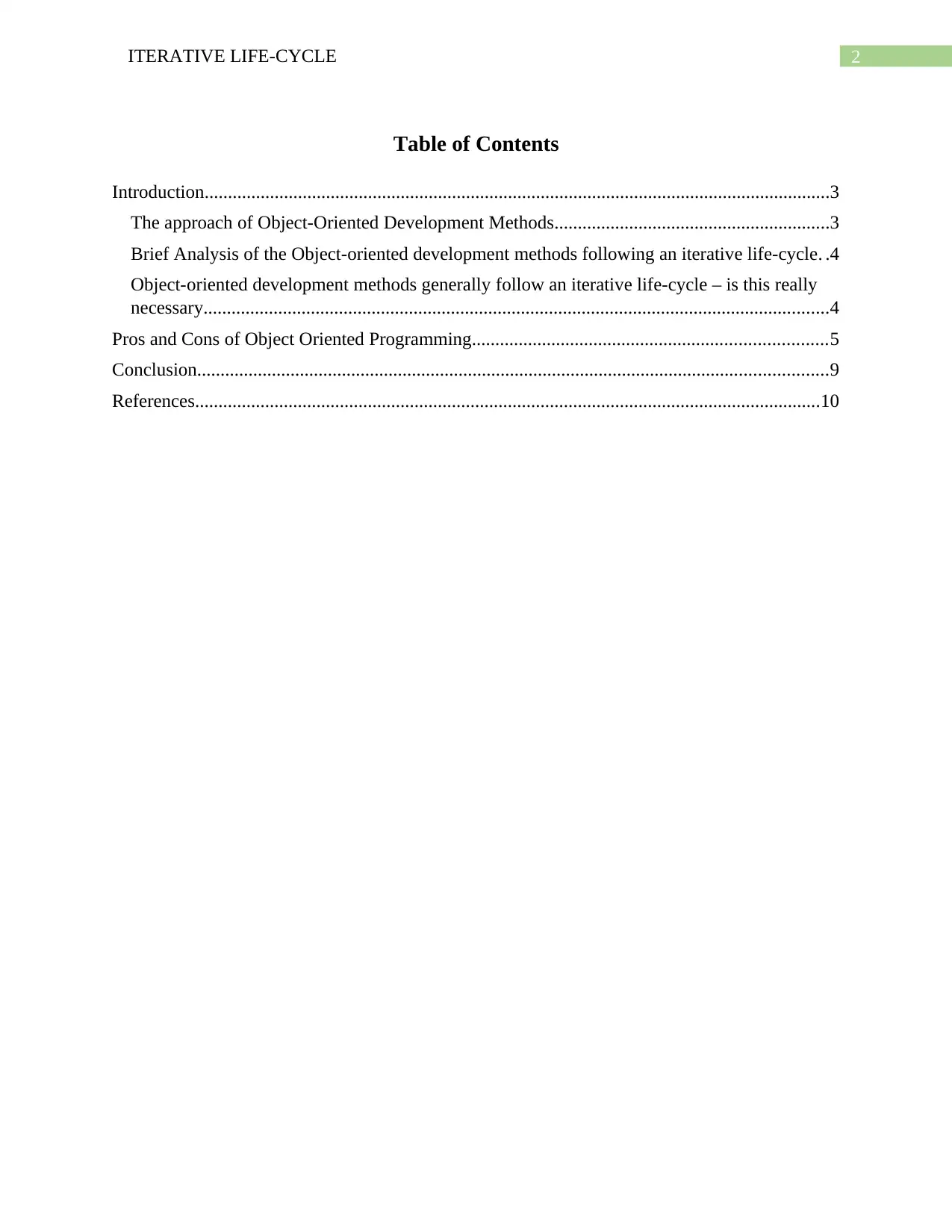
2ITERATIVE LIFE-CYCLE
Table of Contents
Introduction......................................................................................................................................3
The approach of Object-Oriented Development Methods...........................................................3
Brief Analysis of the Object-oriented development methods following an iterative life-cycle. .4
Object-oriented development methods generally follow an iterative life-cycle – is this really
necessary......................................................................................................................................4
Pros and Cons of Object Oriented Programming............................................................................5
Conclusion.......................................................................................................................................9
References......................................................................................................................................10
Table of Contents
Introduction......................................................................................................................................3
The approach of Object-Oriented Development Methods...........................................................3
Brief Analysis of the Object-oriented development methods following an iterative life-cycle. .4
Object-oriented development methods generally follow an iterative life-cycle – is this really
necessary......................................................................................................................................4
Pros and Cons of Object Oriented Programming............................................................................5
Conclusion.......................................................................................................................................9
References......................................................................................................................................10
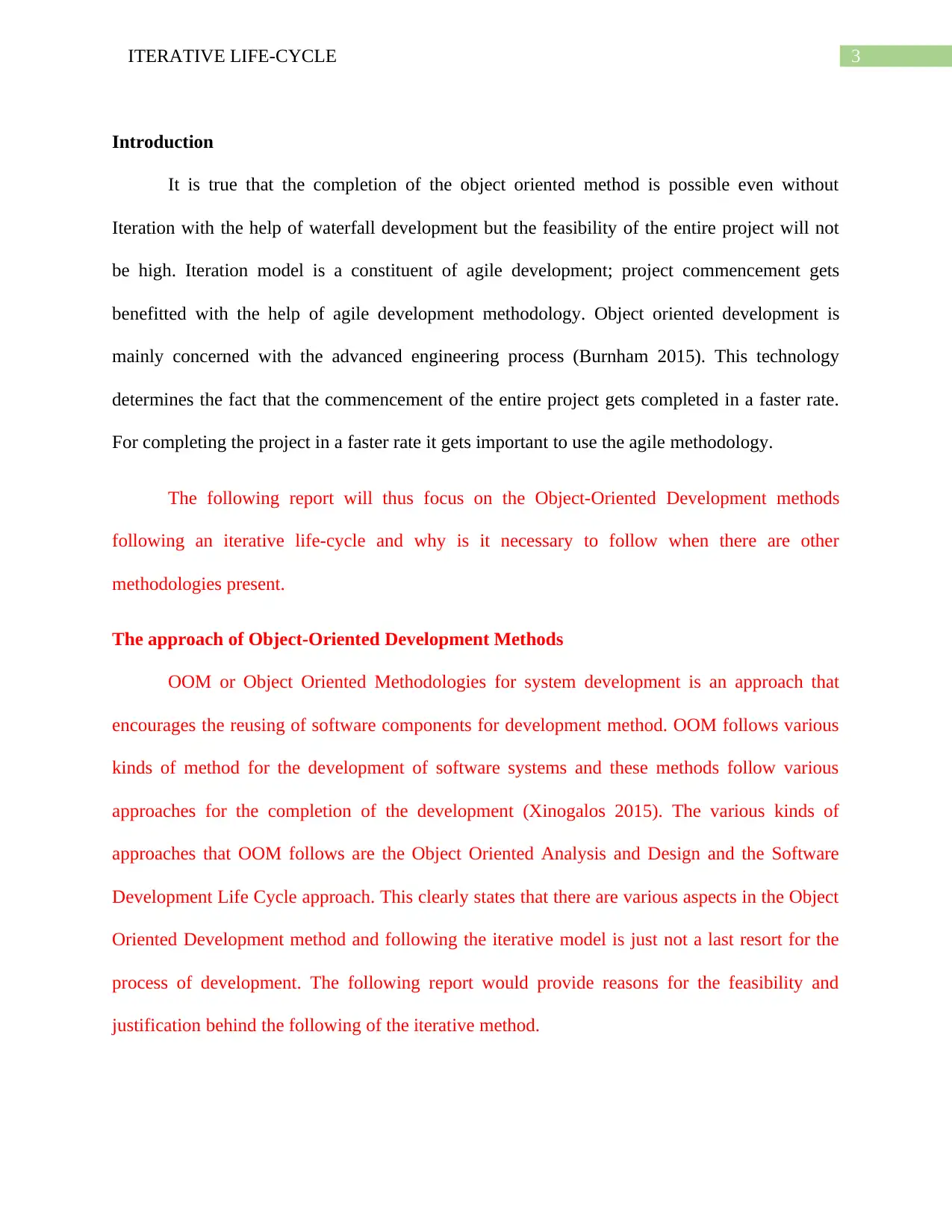
3ITERATIVE LIFE-CYCLE
Introduction
It is true that the completion of the object oriented method is possible even without
Iteration with the help of waterfall development but the feasibility of the entire project will not
be high. Iteration model is a constituent of agile development; project commencement gets
benefitted with the help of agile development methodology. Object oriented development is
mainly concerned with the advanced engineering process (Burnham 2015). This technology
determines the fact that the commencement of the entire project gets completed in a faster rate.
For completing the project in a faster rate it gets important to use the agile methodology.
The following report will thus focus on the Object-Oriented Development methods
following an iterative life-cycle and why is it necessary to follow when there are other
methodologies present.
The approach of Object-Oriented Development Methods
OOM or Object Oriented Methodologies for system development is an approach that
encourages the reusing of software components for development method. OOM follows various
kinds of method for the development of software systems and these methods follow various
approaches for the completion of the development (Xinogalos 2015). The various kinds of
approaches that OOM follows are the Object Oriented Analysis and Design and the Software
Development Life Cycle approach. This clearly states that there are various aspects in the Object
Oriented Development method and following the iterative model is just not a last resort for the
process of development. The following report would provide reasons for the feasibility and
justification behind the following of the iterative method.
Introduction
It is true that the completion of the object oriented method is possible even without
Iteration with the help of waterfall development but the feasibility of the entire project will not
be high. Iteration model is a constituent of agile development; project commencement gets
benefitted with the help of agile development methodology. Object oriented development is
mainly concerned with the advanced engineering process (Burnham 2015). This technology
determines the fact that the commencement of the entire project gets completed in a faster rate.
For completing the project in a faster rate it gets important to use the agile methodology.
The following report will thus focus on the Object-Oriented Development methods
following an iterative life-cycle and why is it necessary to follow when there are other
methodologies present.
The approach of Object-Oriented Development Methods
OOM or Object Oriented Methodologies for system development is an approach that
encourages the reusing of software components for development method. OOM follows various
kinds of method for the development of software systems and these methods follow various
approaches for the completion of the development (Xinogalos 2015). The various kinds of
approaches that OOM follows are the Object Oriented Analysis and Design and the Software
Development Life Cycle approach. This clearly states that there are various aspects in the Object
Oriented Development method and following the iterative model is just not a last resort for the
process of development. The following report would provide reasons for the feasibility and
justification behind the following of the iterative method.
⊘ This is a preview!⊘
Do you want full access?
Subscribe today to unlock all pages.

Trusted by 1+ million students worldwide
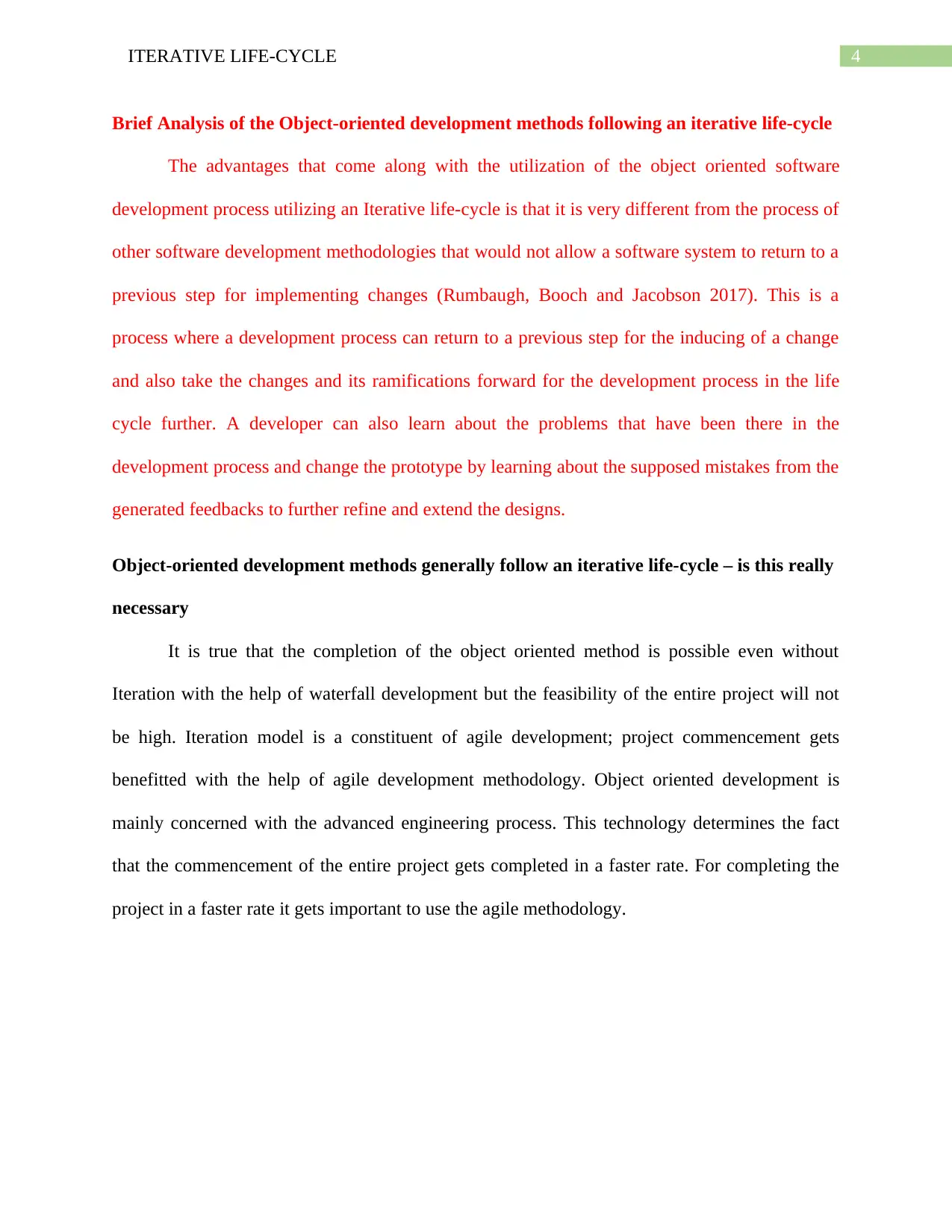
4ITERATIVE LIFE-CYCLE
Brief Analysis of the Object-oriented development methods following an iterative life-cycle
The advantages that come along with the utilization of the object oriented software
development process utilizing an Iterative life-cycle is that it is very different from the process of
other software development methodologies that would not allow a software system to return to a
previous step for implementing changes (Rumbaugh, Booch and Jacobson 2017). This is a
process where a development process can return to a previous step for the inducing of a change
and also take the changes and its ramifications forward for the development process in the life
cycle further. A developer can also learn about the problems that have been there in the
development process and change the prototype by learning about the supposed mistakes from the
generated feedbacks to further refine and extend the designs.
Object-oriented development methods generally follow an iterative life-cycle – is this really
necessary
It is true that the completion of the object oriented method is possible even without
Iteration with the help of waterfall development but the feasibility of the entire project will not
be high. Iteration model is a constituent of agile development; project commencement gets
benefitted with the help of agile development methodology. Object oriented development is
mainly concerned with the advanced engineering process. This technology determines the fact
that the commencement of the entire project gets completed in a faster rate. For completing the
project in a faster rate it gets important to use the agile methodology.
Brief Analysis of the Object-oriented development methods following an iterative life-cycle
The advantages that come along with the utilization of the object oriented software
development process utilizing an Iterative life-cycle is that it is very different from the process of
other software development methodologies that would not allow a software system to return to a
previous step for implementing changes (Rumbaugh, Booch and Jacobson 2017). This is a
process where a development process can return to a previous step for the inducing of a change
and also take the changes and its ramifications forward for the development process in the life
cycle further. A developer can also learn about the problems that have been there in the
development process and change the prototype by learning about the supposed mistakes from the
generated feedbacks to further refine and extend the designs.
Object-oriented development methods generally follow an iterative life-cycle – is this really
necessary
It is true that the completion of the object oriented method is possible even without
Iteration with the help of waterfall development but the feasibility of the entire project will not
be high. Iteration model is a constituent of agile development; project commencement gets
benefitted with the help of agile development methodology. Object oriented development is
mainly concerned with the advanced engineering process. This technology determines the fact
that the commencement of the entire project gets completed in a faster rate. For completing the
project in a faster rate it gets important to use the agile methodology.
Paraphrase This Document
Need a fresh take? Get an instant paraphrase of this document with our AI Paraphraser
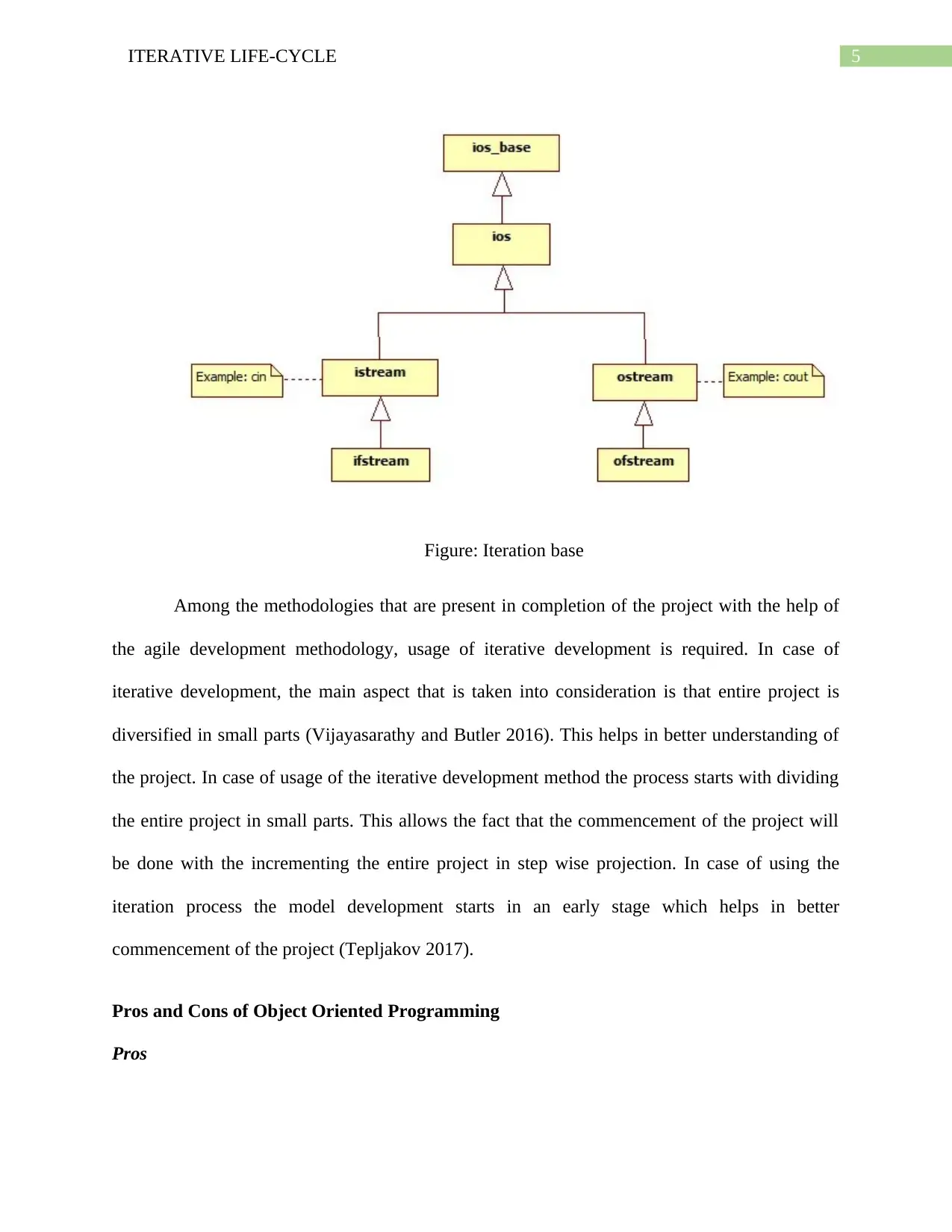
5ITERATIVE LIFE-CYCLE
Figure: Iteration base
Among the methodologies that are present in completion of the project with the help of
the agile development methodology, usage of iterative development is required. In case of
iterative development, the main aspect that is taken into consideration is that entire project is
diversified in small parts (Vijayasarathy and Butler 2016). This helps in better understanding of
the project. In case of usage of the iterative development method the process starts with dividing
the entire project in small parts. This allows the fact that the commencement of the project will
be done with the incrementing the entire project in step wise projection. In case of using the
iteration process the model development starts in an early stage which helps in better
commencement of the project (Tepljakov 2017).
Pros and Cons of Object Oriented Programming
Pros
Figure: Iteration base
Among the methodologies that are present in completion of the project with the help of
the agile development methodology, usage of iterative development is required. In case of
iterative development, the main aspect that is taken into consideration is that entire project is
diversified in small parts (Vijayasarathy and Butler 2016). This helps in better understanding of
the project. In case of usage of the iterative development method the process starts with dividing
the entire project in small parts. This allows the fact that the commencement of the project will
be done with the incrementing the entire project in step wise projection. In case of using the
iteration process the model development starts in an early stage which helps in better
commencement of the project (Tepljakov 2017).
Pros and Cons of Object Oriented Programming
Pros
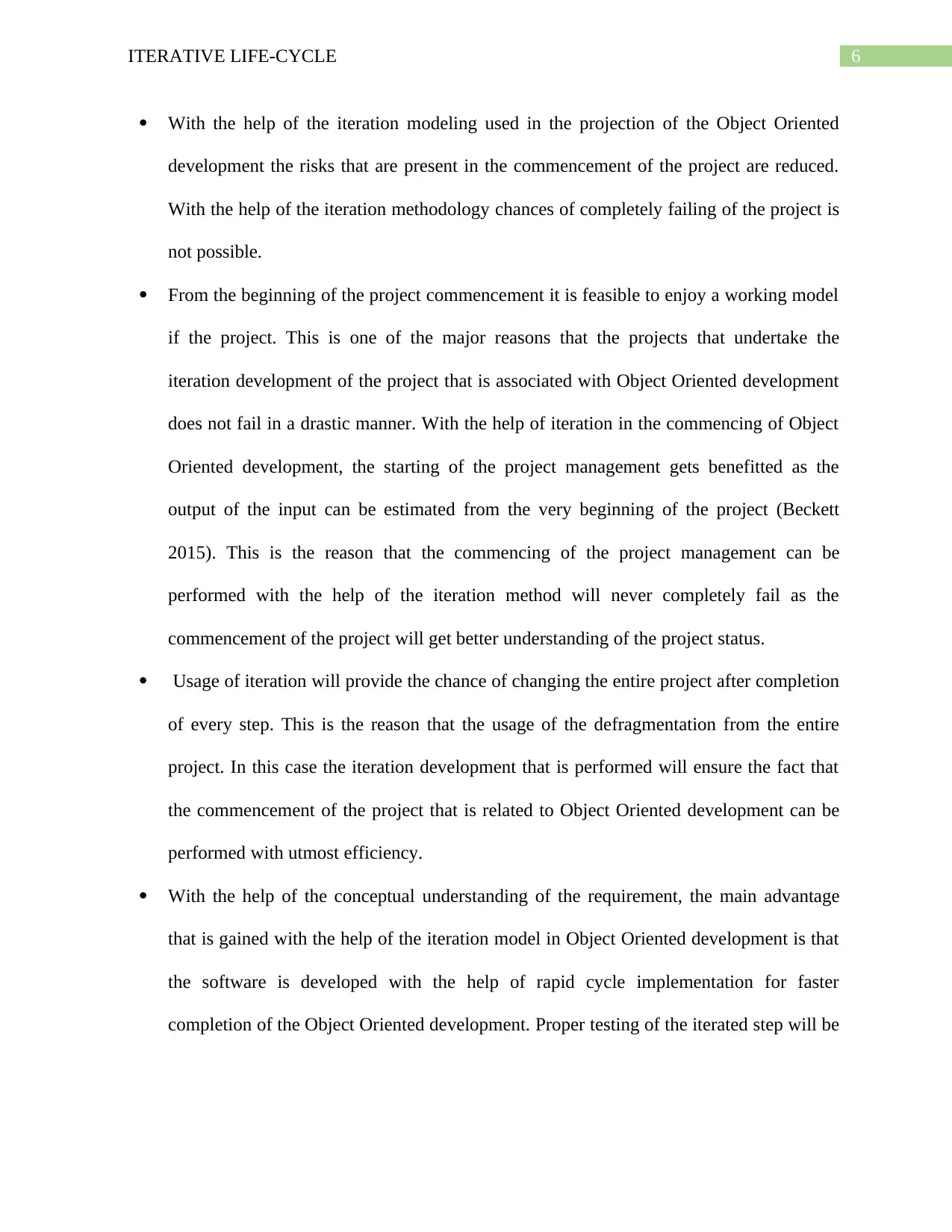
6ITERATIVE LIFE-CYCLE
With the help of the iteration modeling used in the projection of the Object Oriented
development the risks that are present in the commencement of the project are reduced.
With the help of the iteration methodology chances of completely failing of the project is
not possible.
From the beginning of the project commencement it is feasible to enjoy a working model
if the project. This is one of the major reasons that the projects that undertake the
iteration development of the project that is associated with Object Oriented development
does not fail in a drastic manner. With the help of iteration in the commencing of Object
Oriented development, the starting of the project management gets benefitted as the
output of the input can be estimated from the very beginning of the project (Beckett
2015). This is the reason that the commencing of the project management can be
performed with the help of the iteration method will never completely fail as the
commencement of the project will get better understanding of the project status.
Usage of iteration will provide the chance of changing the entire project after completion
of every step. This is the reason that the usage of the defragmentation from the entire
project. In this case the iteration development that is performed will ensure the fact that
the commencement of the project that is related to Object Oriented development can be
performed with utmost efficiency.
With the help of the conceptual understanding of the requirement, the main advantage
that is gained with the help of the iteration model in Object Oriented development is that
the software is developed with the help of rapid cycle implementation for faster
completion of the Object Oriented development. Proper testing of the iterated step will be
With the help of the iteration modeling used in the projection of the Object Oriented
development the risks that are present in the commencement of the project are reduced.
With the help of the iteration methodology chances of completely failing of the project is
not possible.
From the beginning of the project commencement it is feasible to enjoy a working model
if the project. This is one of the major reasons that the projects that undertake the
iteration development of the project that is associated with Object Oriented development
does not fail in a drastic manner. With the help of iteration in the commencing of Object
Oriented development, the starting of the project management gets benefitted as the
output of the input can be estimated from the very beginning of the project (Beckett
2015). This is the reason that the commencing of the project management can be
performed with the help of the iteration method will never completely fail as the
commencement of the project will get better understanding of the project status.
Usage of iteration will provide the chance of changing the entire project after completion
of every step. This is the reason that the usage of the defragmentation from the entire
project. In this case the iteration development that is performed will ensure the fact that
the commencement of the project that is related to Object Oriented development can be
performed with utmost efficiency.
With the help of the conceptual understanding of the requirement, the main advantage
that is gained with the help of the iteration model in Object Oriented development is that
the software is developed with the help of rapid cycle implementation for faster
completion of the Object Oriented development. Proper testing of the iterated step will be
⊘ This is a preview!⊘
Do you want full access?
Subscribe today to unlock all pages.

Trusted by 1+ million students worldwide
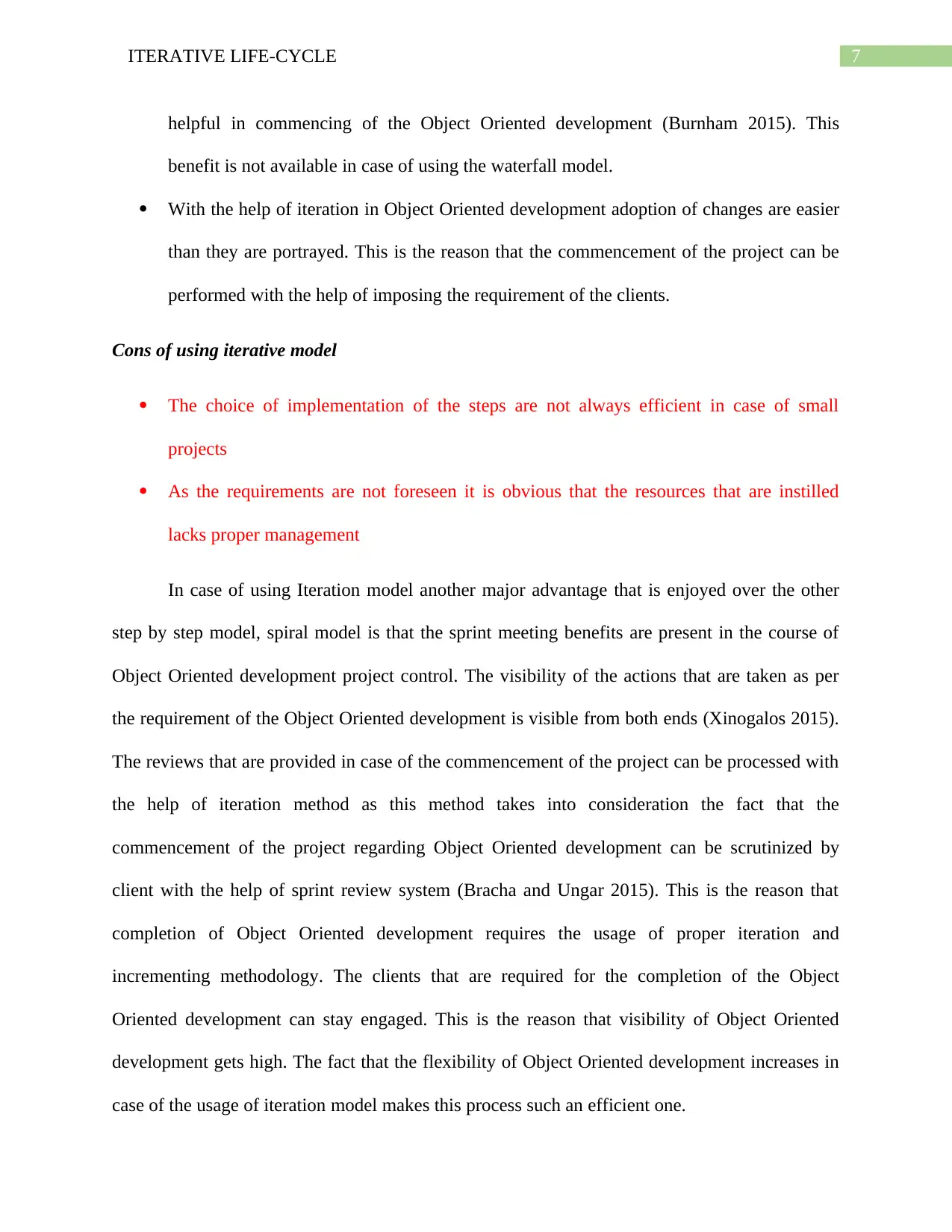
7ITERATIVE LIFE-CYCLE
helpful in commencing of the Object Oriented development (Burnham 2015). This
benefit is not available in case of using the waterfall model.
With the help of iteration in Object Oriented development adoption of changes are easier
than they are portrayed. This is the reason that the commencement of the project can be
performed with the help of imposing the requirement of the clients.
Cons of using iterative model
The choice of implementation of the steps are not always efficient in case of small
projects
As the requirements are not foreseen it is obvious that the resources that are instilled
lacks proper management
In case of using Iteration model another major advantage that is enjoyed over the other
step by step model, spiral model is that the sprint meeting benefits are present in the course of
Object Oriented development project control. The visibility of the actions that are taken as per
the requirement of the Object Oriented development is visible from both ends (Xinogalos 2015).
The reviews that are provided in case of the commencement of the project can be processed with
the help of iteration method as this method takes into consideration the fact that the
commencement of the project regarding Object Oriented development can be scrutinized by
client with the help of sprint review system (Bracha and Ungar 2015). This is the reason that
completion of Object Oriented development requires the usage of proper iteration and
incrementing methodology. The clients that are required for the completion of the Object
Oriented development can stay engaged. This is the reason that visibility of Object Oriented
development gets high. The fact that the flexibility of Object Oriented development increases in
case of the usage of iteration model makes this process such an efficient one.
helpful in commencing of the Object Oriented development (Burnham 2015). This
benefit is not available in case of using the waterfall model.
With the help of iteration in Object Oriented development adoption of changes are easier
than they are portrayed. This is the reason that the commencement of the project can be
performed with the help of imposing the requirement of the clients.
Cons of using iterative model
The choice of implementation of the steps are not always efficient in case of small
projects
As the requirements are not foreseen it is obvious that the resources that are instilled
lacks proper management
In case of using Iteration model another major advantage that is enjoyed over the other
step by step model, spiral model is that the sprint meeting benefits are present in the course of
Object Oriented development project control. The visibility of the actions that are taken as per
the requirement of the Object Oriented development is visible from both ends (Xinogalos 2015).
The reviews that are provided in case of the commencement of the project can be processed with
the help of iteration method as this method takes into consideration the fact that the
commencement of the project regarding Object Oriented development can be scrutinized by
client with the help of sprint review system (Bracha and Ungar 2015). This is the reason that
completion of Object Oriented development requires the usage of proper iteration and
incrementing methodology. The clients that are required for the completion of the Object
Oriented development can stay engaged. This is the reason that visibility of Object Oriented
development gets high. The fact that the flexibility of Object Oriented development increases in
case of the usage of iteration model makes this process such an efficient one.
Paraphrase This Document
Need a fresh take? Get an instant paraphrase of this document with our AI Paraphraser
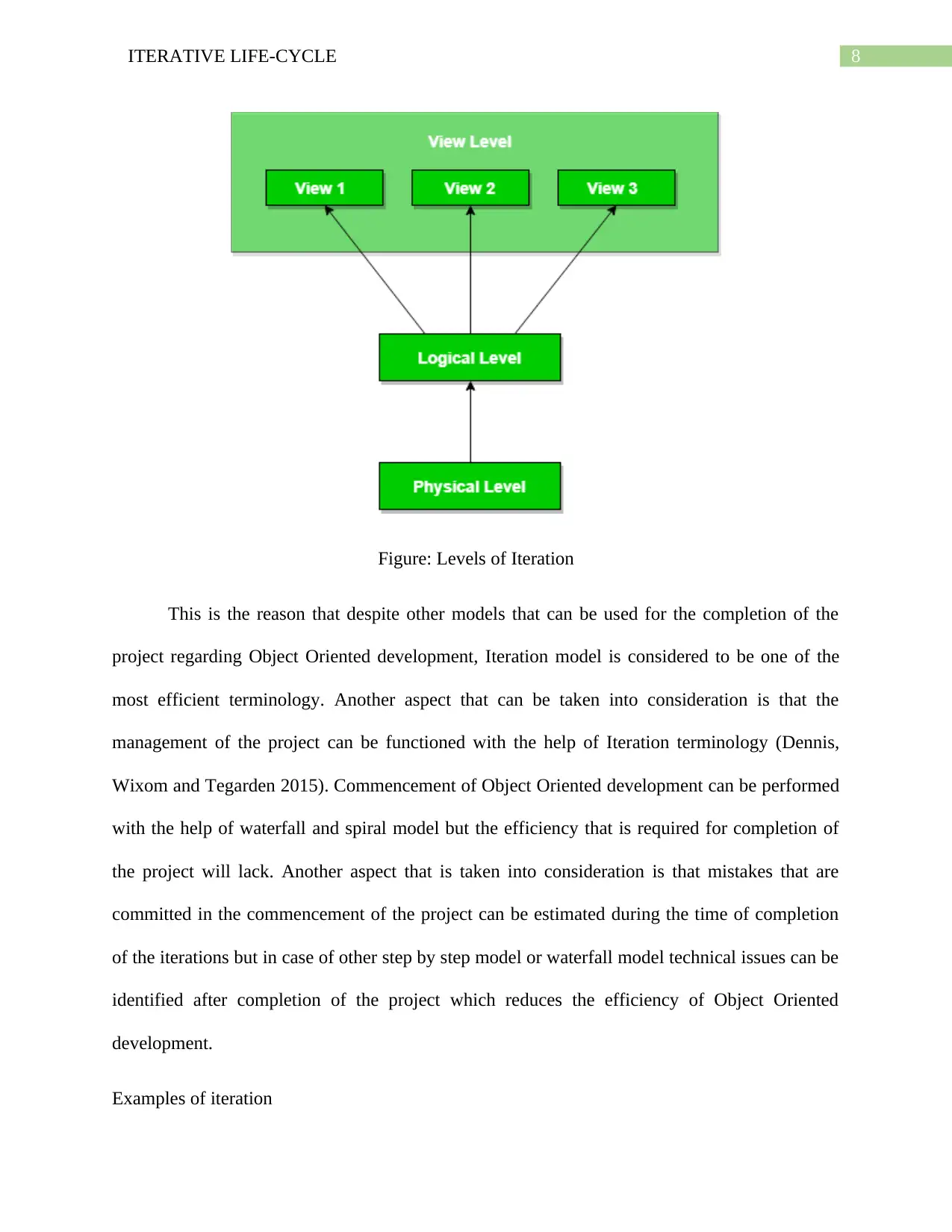
8ITERATIVE LIFE-CYCLE
Figure: Levels of Iteration
This is the reason that despite other models that can be used for the completion of the
project regarding Object Oriented development, Iteration model is considered to be one of the
most efficient terminology. Another aspect that can be taken into consideration is that the
management of the project can be functioned with the help of Iteration terminology (Dennis,
Wixom and Tegarden 2015). Commencement of Object Oriented development can be performed
with the help of waterfall and spiral model but the efficiency that is required for completion of
the project will lack. Another aspect that is taken into consideration is that mistakes that are
committed in the commencement of the project can be estimated during the time of completion
of the iterations but in case of other step by step model or waterfall model technical issues can be
identified after completion of the project which reduces the efficiency of Object Oriented
development.
Examples of iteration
Figure: Levels of Iteration
This is the reason that despite other models that can be used for the completion of the
project regarding Object Oriented development, Iteration model is considered to be one of the
most efficient terminology. Another aspect that can be taken into consideration is that the
management of the project can be functioned with the help of Iteration terminology (Dennis,
Wixom and Tegarden 2015). Commencement of Object Oriented development can be performed
with the help of waterfall and spiral model but the efficiency that is required for completion of
the project will lack. Another aspect that is taken into consideration is that mistakes that are
committed in the commencement of the project can be estimated during the time of completion
of the iterations but in case of other step by step model or waterfall model technical issues can be
identified after completion of the project which reduces the efficiency of Object Oriented
development.
Examples of iteration
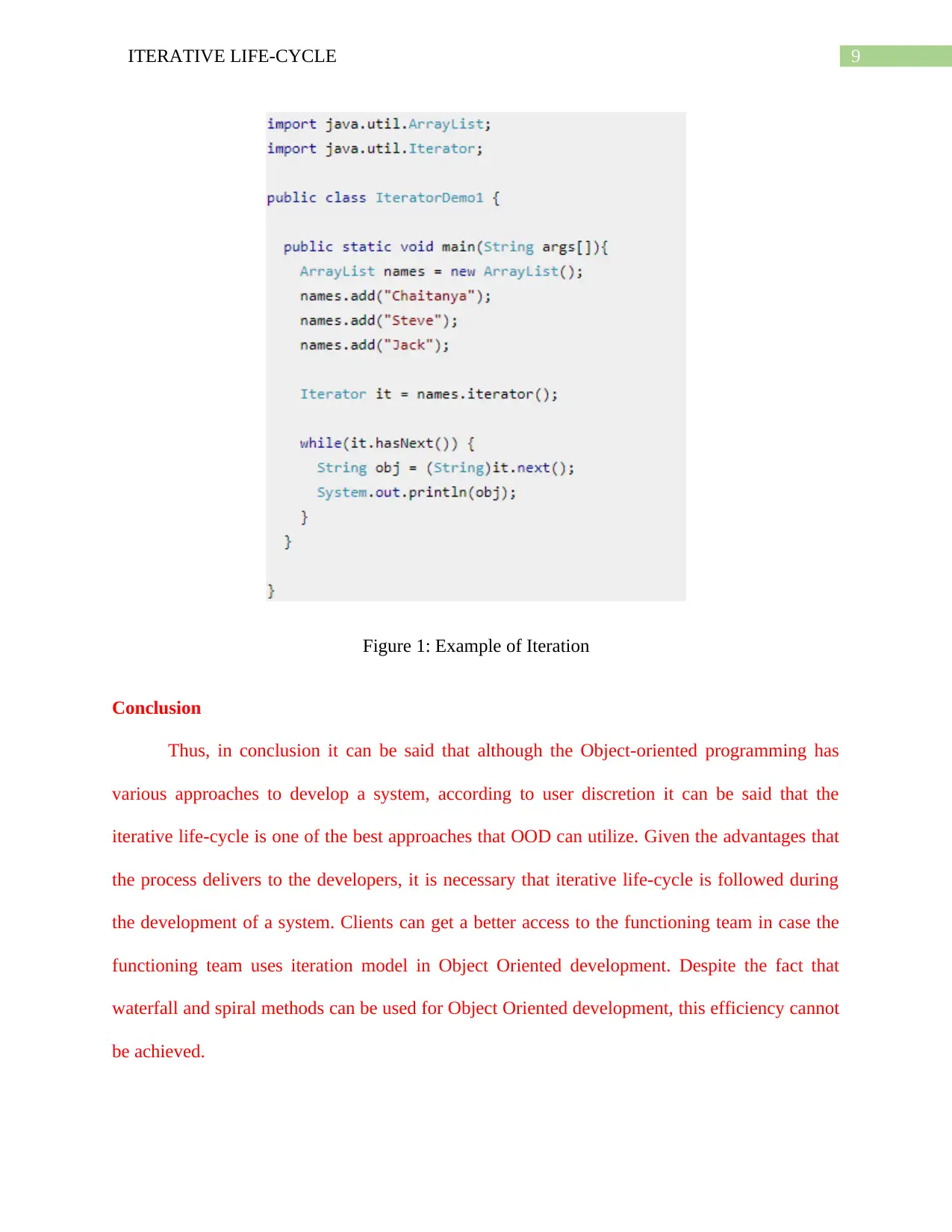
9ITERATIVE LIFE-CYCLE
Figure 1: Example of Iteration
Conclusion
Thus, in conclusion it can be said that although the Object-oriented programming has
various approaches to develop a system, according to user discretion it can be said that the
iterative life-cycle is one of the best approaches that OOD can utilize. Given the advantages that
the process delivers to the developers, it is necessary that iterative life-cycle is followed during
the development of a system. Clients can get a better access to the functioning team in case the
functioning team uses iteration model in Object Oriented development. Despite the fact that
waterfall and spiral methods can be used for Object Oriented development, this efficiency cannot
be achieved.
Figure 1: Example of Iteration
Conclusion
Thus, in conclusion it can be said that although the Object-oriented programming has
various approaches to develop a system, according to user discretion it can be said that the
iterative life-cycle is one of the best approaches that OOD can utilize. Given the advantages that
the process delivers to the developers, it is necessary that iterative life-cycle is followed during
the development of a system. Clients can get a better access to the functioning team in case the
functioning team uses iteration model in Object Oriented development. Despite the fact that
waterfall and spiral methods can be used for Object Oriented development, this efficiency cannot
be achieved.
⊘ This is a preview!⊘
Do you want full access?
Subscribe today to unlock all pages.

Trusted by 1+ million students worldwide
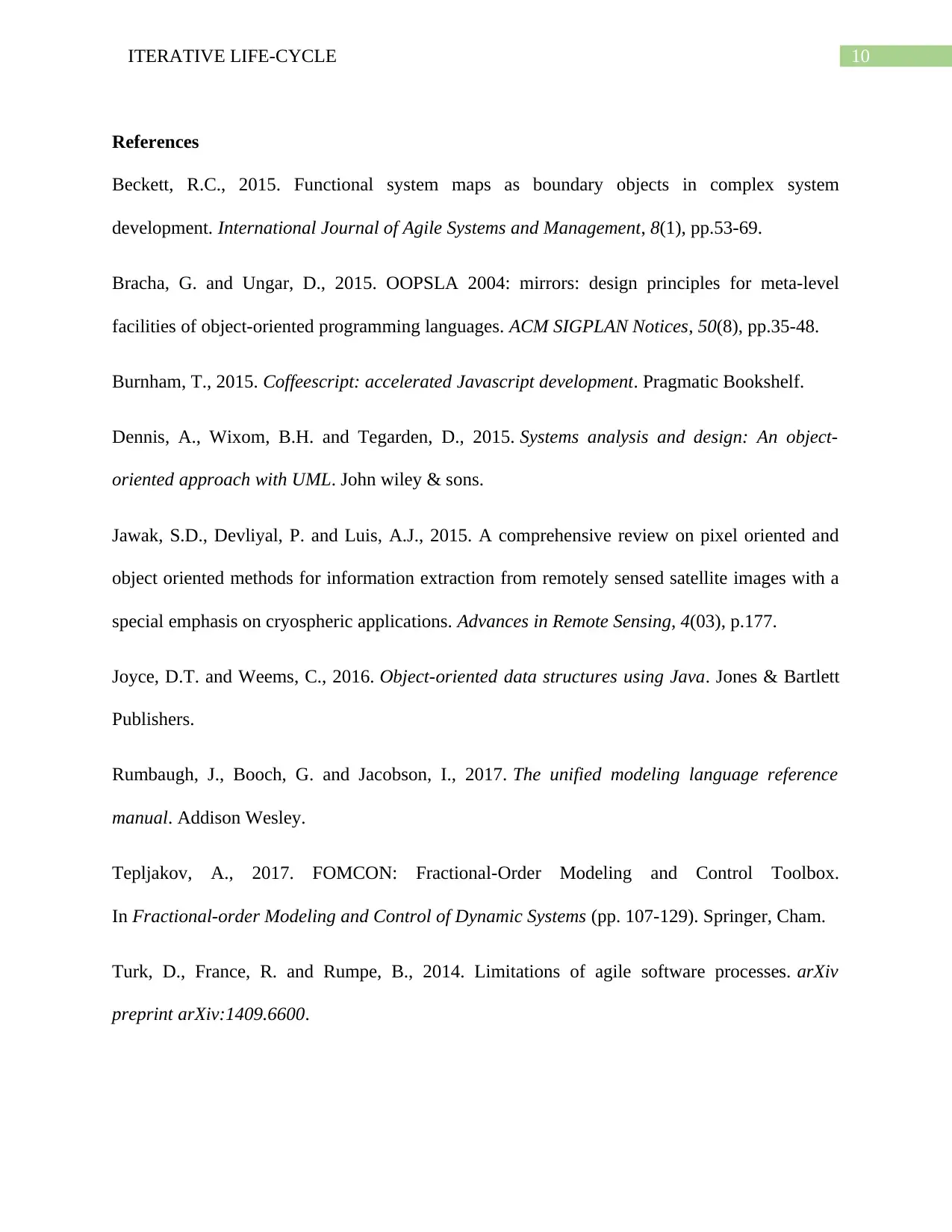
10ITERATIVE LIFE-CYCLE
References
Beckett, R.C., 2015. Functional system maps as boundary objects in complex system
development. International Journal of Agile Systems and Management, 8(1), pp.53-69.
Bracha, G. and Ungar, D., 2015. OOPSLA 2004: mirrors: design principles for meta-level
facilities of object-oriented programming languages. ACM SIGPLAN Notices, 50(8), pp.35-48.
Burnham, T., 2015. Coffeescript: accelerated Javascript development. Pragmatic Bookshelf.
Dennis, A., Wixom, B.H. and Tegarden, D., 2015. Systems analysis and design: An object-
oriented approach with UML. John wiley & sons.
Jawak, S.D., Devliyal, P. and Luis, A.J., 2015. A comprehensive review on pixel oriented and
object oriented methods for information extraction from remotely sensed satellite images with a
special emphasis on cryospheric applications. Advances in Remote Sensing, 4(03), p.177.
Joyce, D.T. and Weems, C., 2016. Object-oriented data structures using Java. Jones & Bartlett
Publishers.
Rumbaugh, J., Booch, G. and Jacobson, I., 2017. The unified modeling language reference
manual. Addison Wesley.
Tepljakov, A., 2017. FOMCON: Fractional-Order Modeling and Control Toolbox.
In Fractional-order Modeling and Control of Dynamic Systems (pp. 107-129). Springer, Cham.
Turk, D., France, R. and Rumpe, B., 2014. Limitations of agile software processes. arXiv
preprint arXiv:1409.6600.
References
Beckett, R.C., 2015. Functional system maps as boundary objects in complex system
development. International Journal of Agile Systems and Management, 8(1), pp.53-69.
Bracha, G. and Ungar, D., 2015. OOPSLA 2004: mirrors: design principles for meta-level
facilities of object-oriented programming languages. ACM SIGPLAN Notices, 50(8), pp.35-48.
Burnham, T., 2015. Coffeescript: accelerated Javascript development. Pragmatic Bookshelf.
Dennis, A., Wixom, B.H. and Tegarden, D., 2015. Systems analysis and design: An object-
oriented approach with UML. John wiley & sons.
Jawak, S.D., Devliyal, P. and Luis, A.J., 2015. A comprehensive review on pixel oriented and
object oriented methods for information extraction from remotely sensed satellite images with a
special emphasis on cryospheric applications. Advances in Remote Sensing, 4(03), p.177.
Joyce, D.T. and Weems, C., 2016. Object-oriented data structures using Java. Jones & Bartlett
Publishers.
Rumbaugh, J., Booch, G. and Jacobson, I., 2017. The unified modeling language reference
manual. Addison Wesley.
Tepljakov, A., 2017. FOMCON: Fractional-Order Modeling and Control Toolbox.
In Fractional-order Modeling and Control of Dynamic Systems (pp. 107-129). Springer, Cham.
Turk, D., France, R. and Rumpe, B., 2014. Limitations of agile software processes. arXiv
preprint arXiv:1409.6600.
Paraphrase This Document
Need a fresh take? Get an instant paraphrase of this document with our AI Paraphraser
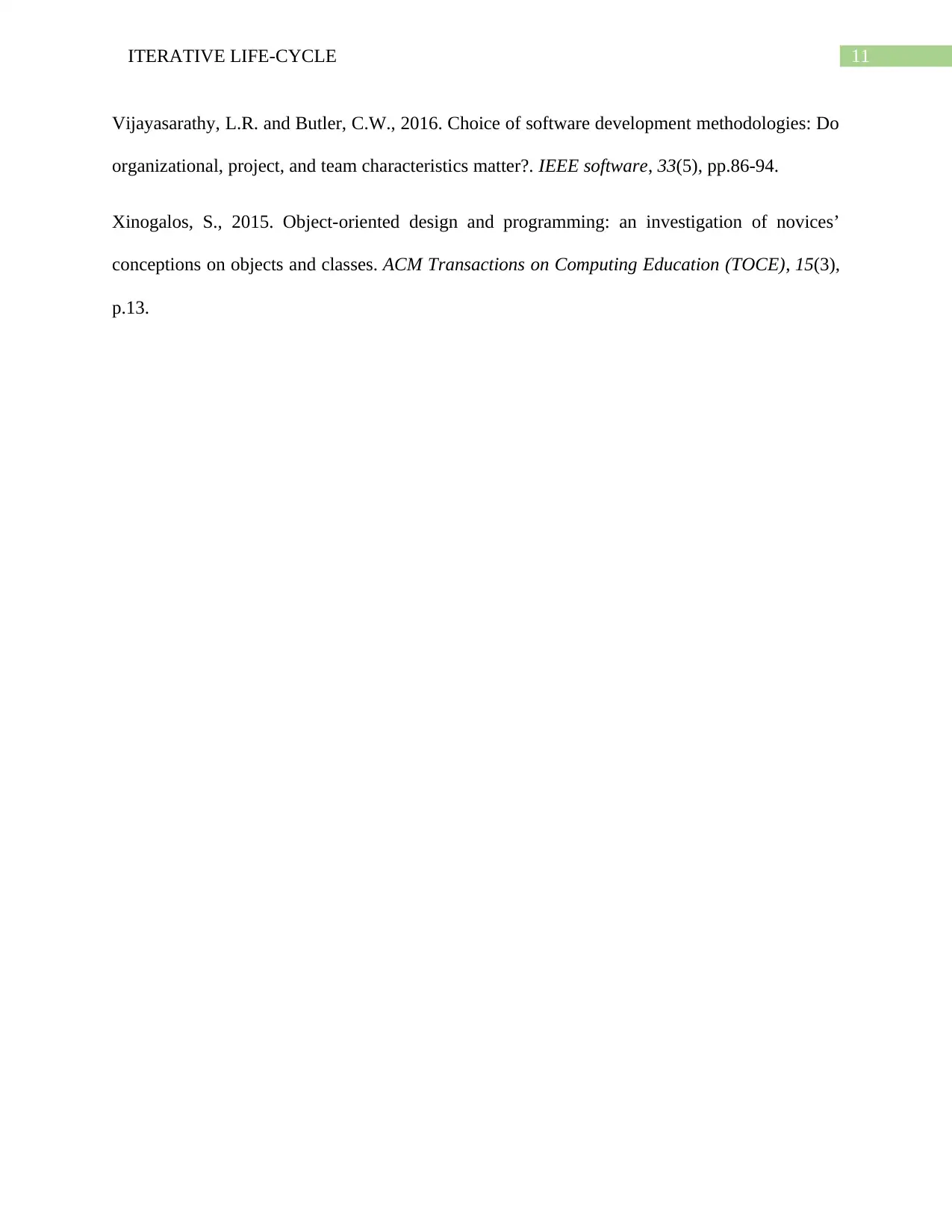
11ITERATIVE LIFE-CYCLE
Vijayasarathy, L.R. and Butler, C.W., 2016. Choice of software development methodologies: Do
organizational, project, and team characteristics matter?. IEEE software, 33(5), pp.86-94.
Xinogalos, S., 2015. Object-oriented design and programming: an investigation of novices’
conceptions on objects and classes. ACM Transactions on Computing Education (TOCE), 15(3),
p.13.
Vijayasarathy, L.R. and Butler, C.W., 2016. Choice of software development methodologies: Do
organizational, project, and team characteristics matter?. IEEE software, 33(5), pp.86-94.
Xinogalos, S., 2015. Object-oriented design and programming: an investigation of novices’
conceptions on objects and classes. ACM Transactions on Computing Education (TOCE), 15(3),
p.13.
1 out of 11
Related Documents
Your All-in-One AI-Powered Toolkit for Academic Success.
+13062052269
info@desklib.com
Available 24*7 on WhatsApp / Email
![[object Object]](/_next/static/media/star-bottom.7253800d.svg)
Unlock your academic potential
Copyright © 2020–2025 A2Z Services. All Rights Reserved. Developed and managed by ZUCOL.



